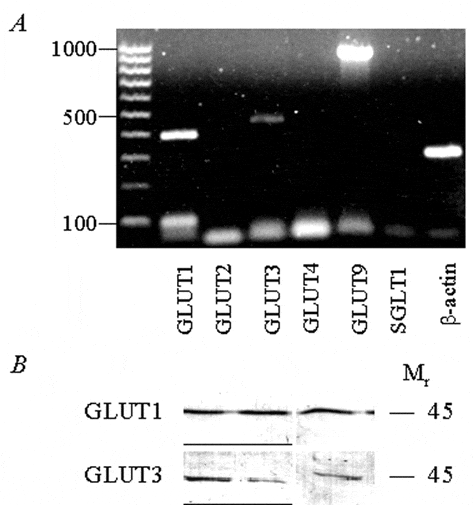Glucose is an important metabolite and a structural precursor for articular cartilage and its transport and regular provision will have significant consequences for the development and functional integrity of the tissue (Wang et al. 1999). Members of the GLUT/SLC2A family catalyse the entry of sugars such as glucose into mammalian cells (Mueckler, 1994). Over a dozen GLUT family members have now been identified on the basis of sequence similarity (Joost et al. 2001). We have previously reported that human articular chondrocytes express mRNA for the ubiquitous GLUT1 and the ‘neuronal’ GLUT3 (Neama et al. 2001). The present investigation was carried out to determine the expression of additional GLUT isoforms and establish the expression of GLUT1 and GLUT3 in chondrocytes at the protein level.
A human cartilage cDNA library was constructed as previously described (Neama et al. 2001). Human-specific oligonucleotide primers were designed to amplify PCR products corresponding to human SGLT1 and GLUTs 1, 2, 3, 4 and 9. PCR reactions consisted of 1 cycle at 95 °C for 1 min followed by 40 cycles at 94 °C for 1 min, 60 °C for 1 min and 72 °C for 1 min and finally 1 cycle at 72 °C. PCR products were separated using 1 % agarose gels and DNA fragments were cloned using a pGEMR-T Easy cloning kit (Promega, USA) and sequenced commercially (MWG-Biotech AG, Germany). Immortalized human chondrocyte-like cells (C20/A4) were cultured in Dulbecco’s modified Eagle’s medium (DMEM) containing 10 % FCS, 1 % ampicillin/streptomycin as monolayer cultures maintained at 37 °C, 5 % CO2. Polyclonal antibodies to GLUT1 and GLUT3 were used to determine the expression and molecular weight of these previously identified GLUTs in chondrocyte membrane fractions by Western blotting.
PCR studies confirmed that GLUT9 (SLC2A9) is also expressed in addition to GLUT1 (SLC2A1) and GLUT3 (SLC2A3) in human articular cartilage (Fig. 1A). PCR products corresponding to the SGLT1, GLUT2 and GLUT4 were undetectable. Sequencing of the PCR products shown in Fig. 1A confirmed expression of GLUT1, GLUT3 and GLUT9 in human cartilage. The GLUT1 and GLUT3 sequences have been deposited in GenBank (Neama et al. 2001). The GLUT9 sequence obtained has been submitted to Genbank (awaiting accession number) and was found to be 100 % identical to nucleotides 317 to 1217 of the Homo sapiens facilitated glucose transporter, member 9, GLUT9 (SLC2A9). GLUT9 is a recently cloned glucose transporter whose kinetic properties are unknown but it is expressed in liver, kidney and several tumour tissues (Phay et al. 2000). Western blots revealed the presence of 45 kDa bands corresponding to GLUT1 and GLUT3 in human chondrocyte-like cells (Fig. 1B). The results presented clearly show that human chondrocytes express at least three facilitative glucose transporters, one of which is a high-affinity (low Km) transporter (i.e. GLUT3). This multitude of GLUT isoform diversity suggests a highly specialised handling of glucose by several members of the GLUT/SLC2A gene family in chondrocytes.
This work was supported by the University of Liverpool Research Development Fund (ADVC5Y).

